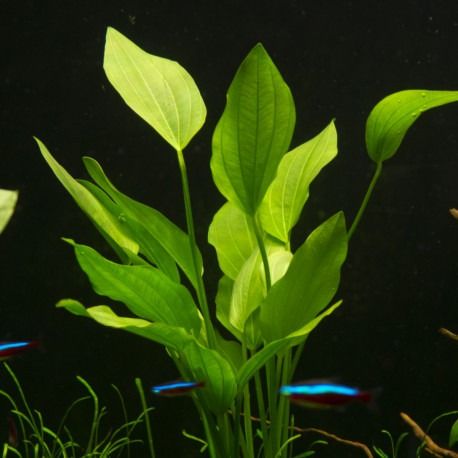Overview: Popular as the Mexican Sword Plant, Echinodorus palaefolius belongs to the Echinodorus genus and is native to South America. It can be seen growing in slow-moving streams, rivers, wetlands, etc., in the wild. While it is not as popular as other species of Echinodorus, it has gained popularity recently due to its unique characters and aesthetic value. Easy to care and maintain, it is perfect for beginners as well. At the same time, the compact size and medium growth make it suitable for all sizes of aquariums.
Appearance: Echinodorus palaefolius features long, narrow, and lance-shaped leaves. The color of the leaves varies in shades of light to dark green, depending upon the water conditions. The leaves grow in a rosette formation, and the plant can reach a height of approximately 25–30 cm, making it suitable for planting in the middle. The leaves are more delicate than other species of Echinodorus. It is one of the best aquarium plants that aquarists can use to create a lush-green aquascape.
Hard/Soft Plant: Echinodorus palaefolius is a moderately hard plant that is suitable for beginners. It is neither too demanding nor needs extreme maintenance. The plant is adaptable to a variety of water conditions, although it thrives in stable environments with suitable lighting and nutrient levels.
Ideal water temperature: The optimal temperature range for Echinodorus palaefolius is between 22 and 28 degrees Celsius. The plant will grow best within this temperature window, and while it can tolerate minor fluctuations, stable temperatures are crucial for encouraging healthy growth.
Lighting condition: Moderate to high light conditions will favor the growth of Echinodorus palaefolius. When adequate light is provided, the plant shows bright and vibrant green coloration with healthy vigor. In general, 8 to 10 hours of light per day will be sufficient for this plant to show the best result.
Ideal pH Condition: The ideal pH range for Echinodorus palaefolius is between 6.5 and 7.5. Extreme pH levels, either too acidic or too alkaline, can lead to poor growth and other signs of stress, such as yellowing or distorted leaves.
Other requirements: As with most Echinodorus species, Echinodorus palaefolius prefers a nutrient-rich substrate to support healthy root development. Root tabs or liquid fertilizers can also be added to ensure the plant receives essential nutrients. While not a strict requirement, adding CO2 to the aquarium can help promote faster growth and more vibrant leaf coloration. Regular trimming is necessary to maintain the plant's appearance and prevent overgrowth.
Propagation: Echinodorus palaefolius propagates through runners that grow along the substrate and produce new plantlets. Once the plantlets have established roots, they can be separated from the mother plant and replanted.
Do You Know: One of the distinguishing features of Echinodorus palaefolius compared to other Echinodorus species is its compact size. This makes it a great choice for smaller aquariums or aquascapes where larger plants might be too imposing. It works well in mid-ground or foreground positions, depending on the size of the tank.
















